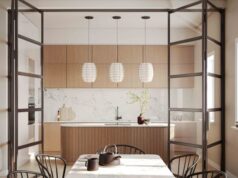
The lighting design in your kitchen will make a vast difference to how comfortable and safe it is, as well as to how good it ends up looking. Learn the right way to plan and arrange lighting in your kitchen.

It’s no secret that the kitchen is the natural centre of all household activities – it’s a home office, a place for kids to do their homework, and a place where family and friends inevitably end up congregating. For that reason, kitchen lighting has to be functional, and at the same time inviting.
More than that though, the kitchen is the one area where a traditional project builder’s approach to lighting – one socket in the centre of the room – is not only inconvenient, but downright dangerous. In a kitchen lit by a single, central light, every function (preparation, cooking, serving and cleaning) is carried out in your own shadow. Even if you’re on the most limited budget, it’s very important to have properly planned task lighting in your kitchen.
Kitchen lighting design fundamentals
The following tips will give you a broad understanding of what sorts of lighting best suit kitchen setups, and how to plan to ensure that your lighting’s as effective, functional and attractive as it needs to be:
- Pelmet lighting above the window will provide general lighting similar to daylight.
- Benchtops can be lit from above, by lights under the wall cupboards or set in the ceiling where there are no cupboards.
- Track lighting can be incredibly useful in areas of food preparation and cooking. If you have cabinets higher than the bench, use track lighting under them to produce extra light in work areas.
- Remember, use lights with a warmer colour temperature to ensure good colour rendering of food. If you’re opting for fluorescent or LED light fittings, choose some that can be fitted with warm, white lamps that match the colour of the incandescent lamps.
- Consider an overhead halogen downlight where people eat breakfast, as people often use this area to read the newspaper. Halogen downlights provide good reading light.
- Natural light is very important. Consider a skylight over kitchen benches and work areas to bring more light in.
- Reflective surfaces can play a useful role in spreading natural light – stainless steel benches and kitchen appliances reflect a lot of light around a room.
- For decoration, try and think outside the box – you could include lighting on pot racks, along the kickboards, or accent lighting on artwork or ornaments.
The shortcomings in a badly designed kitchen lighting system will very quickly become obvious. Not only will they impair your ability to get things done in the kitchen, but they also have the potential to pose serious safety risks.





